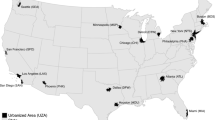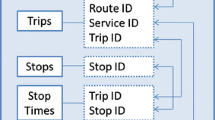Concluding remarks
Thomas Borcherding (1977), in commenting on the public-versus-private literature, offered the generalization that removal of an activity from the private to the public sector will double its unit costs of production. The results of this paper obviously are not consistent with Borcherding's ‘rule of two’ generalization. At the same time, however, the 12% cost-per-mile differential in favor of private ownership indicated by the results for the overall sample is not a trivial sum in absolute terms. The cost-per-mile differences in favor of private buses contained in the five trip groups are not trivial either, nor is the direct evidence from the 82 joint systems. In attempting to assess the results, much depends on the perspective against which they are judged.
Several factors suggest themselves concerning the ‘smallness’ of the differential. First, school bus transportation is a part of the education budget. Despite the lack of incentives implicit in public ownership, competition within the educational bureaucracy for a limited budget can result in ‘abnormally’ low cost public ownership. Second, and related to the first, is the fact that public and private ownership are in close proximity to each other — sometimes within the same school district. This proximity may lead to additional competitive pressures on public ownership. That school district residents can relocate based on school transportation considerations adds to this competitive pressure. To the extent that these first and second factors account for the smallness of the differential, our statistical results are consistent with the hypothesis that it is not public ownership per se that produces more costly public operations but, rather, the lack of effective competition. Third, although the contracting system is administered through open, competitive bidding, the district administrator responsible for the process has no direct claim on a dollar saving realized by the process. One would think that actual bid prices might be lower if the administrator's incentive to secure a lower bid price were greater. Finally, note that school bus transportation is technologically simple. Thus, private owners have less room to be innovative and entrepreneurial, meaning a reduced differential between public and private ownership.
On the other side of the ledger, it remains that private ownership appears less costly. To explain the estimated cost differences in this study in an economic sense is to explain where the lack of incentive effects in public ownership find their outlets in terms of higher costs. Two primary factors appear to be responsible for the ‘largeness’ of the cost differential. First, as stated earlier, district-owned buses in Indiana are newer than contractor-owned buses. Capital costs related to public ownership — forgone interest income and economic depreciation — are, therefore, greater than these costs for private ownership. To the extent that this newer age structure is not indicative of higher quality output, it follows that school district officials, who do not have a direct claim on the benefits of economizing on capital, are providing higher capital cost transportation. Second, trip lengths for district-owned buses are shorter than the trip lengths of contractors. With declining cost per mile as trip length increases, shorter trip lengths imply higher cost per mile. Again, district officials and public bus drivers have less incentive to efficiently design bus routes served by district-owned buses; whereas one would expect the input of private contractors to impact favorably on the design of private routes.
Even though the results of this study do not support the Borcherding generalization, they are still strong enough to have important public policy implications. The fact that almost 70% of school buses in the United States are district owned and to the extent that Indiana cost experience approximates that of the other states, substantial dollar savings could result from privatizing the provision of school bus transportation.
Similar content being viewed by others
References
Bails, D. (1979). Provision of transportation services. Public Choice 34(1): 65–68.
Bennett, J.T., and Johnson, M.H. (1979). Public versus private provision of collective goods and services: Garbage collection revisited. Public Choice 34(1): 55–63.
Bennett, J.T., and Johnson, M.H. (1980). Tax reduction without sacrifice: Private-sector production of public services. Public Finance Quarterly 8: 363–396.
Borcherding, T.E. (1977). The sources of growth in public expenditures in the U.S., 1902–1970. In T.E. Borcherding (Ed.), Budgets and bureaucrats: The sources of government growth, 45–70. Durham, N.C.: Duke University Press.
Borcherding, T.E., Pommerehne, W.W., and Schneider, F. (1982). Comparing the efficiency of private and public production: The evidence from five countries. Zeitschrift für Nationalökonomie, Supplement 2 (Public Production): 127–156.
Caves, D.W., and Christensen, L.R. (1980). The relative efficiency of public and private firms in a competitive environment: The case of Canadian railroads. Journal of Political Economy 88: 958–976.
De Alessi, L. (1980). The economics of property rights: A review of the evidence. Research in Law and Economics 2: 1–47.
Harrison, A.J. (1974). The economics of transport. New York: Wiley.
Indiana Code, a. Indiana pupil transportation statute, IC 20-9.1.
Indiana Code, b. Motor vehicle excise tax statute, IC 6-6-5-1 (A) (5).
Indiana Department of Public Instruction. (1978). Indiana minimum specification for school buses. May.
Indiana Department of Public Instruction. (1979). Transportation report, EIR-5. September.
Indiana Department of Public Instruction. (1980a). Biannual financial report, Form 9A. February and August.
Indiana Department of Public Instruction. (1980b). Report for handicapped pupil transportation, Form 30A.
Indiana Department of Public Instruction. (1980c). Report for vocational transportation, Form 30A.
Indiana State Police. (1981). Uniform school bus inspection and procedure manual. July.
Kansas State Department of Education (1977). Annual statistical report 1976–77.
Minnesota State Department of Education (1977). 1976–77 School buses.
Missouri Department of Elementary and Secondary Education (1977). Ownership — type of vehicles 1976–77.
National Association of State Directors of Pupil Transportation Services, (1982). Statistics on school transportation 1979–80. In School bus fleet 26: 60–61.
New Mexico State Department of Education (1977). School bus transportation 1976–77.
Niskanen, W.A. (1968). The peculiar economics of bureaucracy. American Economic Review 58: 293–305.
Niskanen, W.A. (1971). Bureaucracy and representative government. Chicago: Aldine-Atherton.
Oregon Department of Education (1977). Oregon pupil transportation statistics 1976–77 Data.
Roess, R.P. (1974). Operating cost models for urban public transportation systems and their use in analysis. In R.P. Roess, Cost-benefit and other economic analyses of transportation, 40–54. Washington, D.C.: Transportation Research Board.
South Dakota Department of Education and Cultural Affairs (1977). Transportation memorandum 1976–77.
Spann, R.M. (1977). Public versus private provision of governmental services. In T.E. Borcherding (Ed.), Budgets and bureaucrats: The sources of government growth, 71–89. Durham, N.C.: Duke University Press.
Author information
Authors and Affiliations
Rights and permissions
About this article
Cite this article
McGuire, R.A., Van COTT, T.N. Public versus private economic activity: A new look at school bus transportation. Public Choice 43, 25–43 (1984). https://doi.org/10.1007/BF00137903
Issue Date:
DOI: https://doi.org/10.1007/BF00137903




